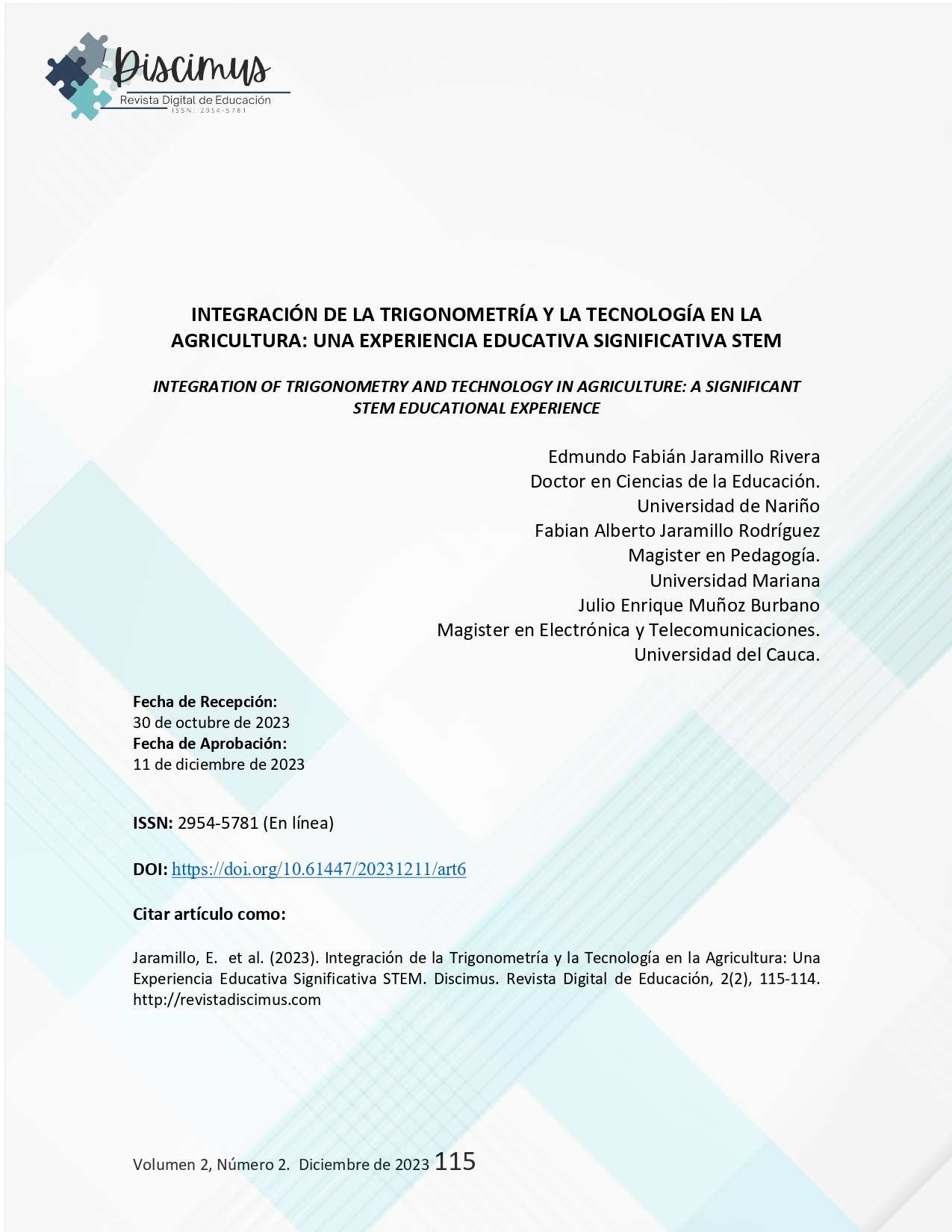Integration of trigonometry and technology in agriculture: a significant stem educational experience
DOI:
https://doi.org/10.61447/20231211/art6Keywords:
STEM, Trigonometry, didactics, precision agricultureAbstract
The present significant experience with a STEM focus comes from the pedagogical practice in the classroom in the area of mathematics and the initiative of the tenth grade students of the Los Libertadores Educational Institution of the municipality of Consacá, Nariño.
Its development, results and accompaniment focus on solving challenges of teaching and learning trigonometry through the integration of technology in the sowing process using a "T" shaped tool with Microbits programmed with sensors such as the magnetometer and accelerometer simulating the functionalities of a theodolite, compass, clinometer, odometer among other useful measurement tools to improve orientation in the terrain, calculate the inclination slope and measure distances between furrows and plants, thus allowing to determine an effective planting line , optimal density and calculation of distances between crest ditches or living barriers to avoid the environmental problem of erosion.
The innovation of this project consists in the relationship of the classroom with the precision agriculture processes typical of industries 4.0, optimizing agricultural processes promoting more precise and sustainable management. Results include a greater understanding of trigonometric ratios and their application, as well as the development of technological skills and critical thinking in students. This project was recognized by the Computers to Educate program of the Colombian National Government as the winner of the Pacific region in the category "Significant Experiences with a STEM focus" in the “Educa Digital Regional” call. And representative of the national Educa Digital Nacional meeting that will take place in Bogotá on November 8, 9 and 10, 2023. It is shared online for replication on the WEB page experiencestemsmartt.godaddysites.com, and its expansion is planned through training and alliances with educational and agricultural institutions.
Downloads
References
Álvarez, D. B., Chorolque, E. M., Villagra, C. E., & Miguez, I. H. (2022). Comprensión de algunas nociones básicas de trigonometría enfatizando la visualización y uso de registros semióticos de representación. Jornadas de Enseñanza de la Matemática, 12-15.
Bolaños, E. C., Dorado, A. N., Guerrero, M. F., Guzmán, V., Martinez, A. K., Meneses, I. J.,… Zambrano, J. E. (2015). Revisión y ajuste al esquema de ordenamiento territorial, municipio de Consacá (Tesis de Pregrado). Universidad de Nariño, Pasto, Colombia. http://biblioteca.udenar.edu.co:8085/atenea/biblioteca/90809.pdf
Carrasco, J., Riquelme, J., Squella, F., Hirzel, J., & Uribe, H. (2012). Técnicas para el control de la erosión. Técnicas de conservación de suelos, agua y vegetación en territorios degradados, 23-48.
Jaramillo, F. A. (2021). Comprensión de los conceptos de las razones trigonométricas mediante el entrenamiento de las artes marciales mixtas en los estudiantes del grado décimo de la Institución Educativa Los Libertadores del Municipio de Consacá. [Tesis de Maestria]. Universidad Mariana.
Cornejo, A. M. C., Aranzamendi, J. M., & Machaca, E. R. M. (2019). Consideraciones epistemológicas acerca de la diferencia de la ciencia formal y ciencia fáctica: un aprendizaje básico. Scientae & Methodus, 1(1).
Qué es Micro:Bit - Microes.org - Comunidad Micro:bit en España. (s. f.). http://microes.org/que-es-microbit.php
Medina-Delgado, D. L., Serpa-Jiménez, A. M., & Ramírez-Leal, P.(2023) Estrategia didáctica para fortalecer la aplicación de las razones trigonométricas a la solución de situaciones problema. XIX Versión Matemática Aplicada-XIV Versión Estadística–2023. https://ww2.ufps.edu.co/public/archivos/pdf/3937789a488d68adacc0f5d59fb210c1.pdf#page=49
Ministerio de Educación Nacional [MEN]. (1998). Serie lineamientos curriculares: Matemáticas. https://www.mineducacion.gov.co/1621/articles-89869_archivo_pdf9.pdf
Ministerio de Educación Nacional [MEN]. (2006). Estándares básicos de competencias en lenguaje, matemáticas, ciencias y ciudadanas: guía sobre lo que los estudiantes deben saber y saber hacer con lo que aprenden (Documento núm. 3).
Rendón, J. R., & Bermúdez, L. N. (2017). Criterios para el establecimiento de cultivos de café en Colombia.
Sanders, M. (2009). STEM, STEM education, STEMmania. The Technology Teacher, 68(4), 20-26. https://eric.ed.gov/?id=EJ821633
Sistema Integrado de Matrículas [SIMAT]. (2020). Base de datos de matrículas, cohorte 2020. https://www.sistemamatriculas.gov.co/simat/app
Vera, M. M. S. (2023). Los desafíos de la Tecnología Educativa. RiiTE Revista Interuniversitaria de Investigación en Tecnología Educativa, 1-5. https://doi.org/10.6018/riite.57213
Vitola, Fernando. (2023). Enseñanza y aprendizaje de la trigonometría: Un abordaje desde las investigaciones doctorales en educación matemática. GACETA DE PEDAGOGÍA. 228-253. 10.56219/rgp.vi45.1900.

Downloads
Published
Issue
Section
License
Copyright (c) 2024 Edmundo Fabián Jaramillo Rivera, Fabian Alberto Jaramillo Rodríguez, Julio Enrique Muñoz Burbano (Autor/a)

This work is licensed under a Creative Commons Attribution-NonCommercial-ShareAlike 4.0 International License.
Open Access Policy at Discimus Journal
Discimus Journal is committed to the promotion of free circulation of scientific and academic knowledge, simultaneously ensuring appropriate acknowledgment for our authors while adhering to the ethical principles of scientific publishing. In alignment with this goal, Discimus publishes all its articles under the ATTRIBUTION-NONCOMMERCIAL-SHAREALIKE 4.0 INTERNATIONAL CC BY-NC-SA 4.0
What does this imply for authors, readers, and the scientific community?
1. Usage Freedom: Under the license CC BY-NC-SA 4.0, anyone is allowed to share (copy and redistribute the material in any medium or format) and adapt (remix, transform, and build upon the material) the articles published in Discimus, for any purpose, including commercially.
2. Attribution: Users must give appropriate credit, provide a link to the license, and indicate if changes were made to the original work. This credit must include the author's citation, the article title, the publication in Discimus, and, if feasible, the DOI of the article. This attribution should not in any way suggest that the authors or Discimus endorse the use made of the work.
3. Share Alik: If users remix, transform, or build upon the material, they must distribute their contributions under the identical license as the original.









